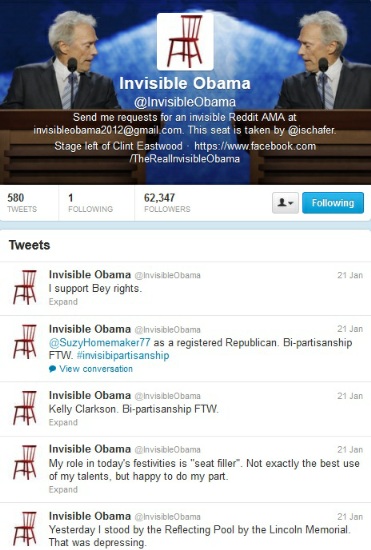
Image Credit: Screenshot from Twitter
Inauguration officials estimate that about one million people crowded the National Mall this weekend to watch Barack Obama be sworn in as President. While this crowd was smaller than the 1.8 million who attended his first inauguration in 2008, a number of luminaries were present: Beyoncé, Stevie Wonder, and Invisible Obama. Apparently Invisible Obama had a busy day planning his inaugural ball outfit, surprising Senate Minority Leader Mitch McConnell, and acting as a “seat filler.”
In case you’re wondering who Invisible Obama is, he is a parodic Twitter feed started during the 2012 Republican National Convention. As Clint Eastwood lectured an empty chair occupied by an imaginary Obama, Invisible Obama tweeted his responses back. Over the course of this last year’s presidential campaign, a number of individuals used new media platforms to satirically comment on the election and the debate. Yet despite the fact that the election is over, however, Invisible Obama persists in commenting on political developments and other invisibility-related issues (like Lennay Kekua). As I spent two weeks of December in Boston reviewing myriad eighteenth-century political satires for my dissertation, this moment finds me thinking about satire’s evolution from the eighteenth century to our present age. New forms of media—and the new possibilities for remediation that they offer—create different opportunities for rhetors. In other words, as the 1662 Licensing Act’s lapse and evolving engraving practices enabled satire’s rise during the eighteenth century, new media platforms like Twitter and Tumblr expand satire’s spread today. However, it seems worth asking whether or not the various proliferating political memes truly function as satire. Can we compare Twitter’s Paul Ryan Gosling to Jonathan Swift’s A Modest Proposal? And what insights does the comparison provide? What kinds of political impact can satire make? And in what ways does it persist within the popular political discourse?
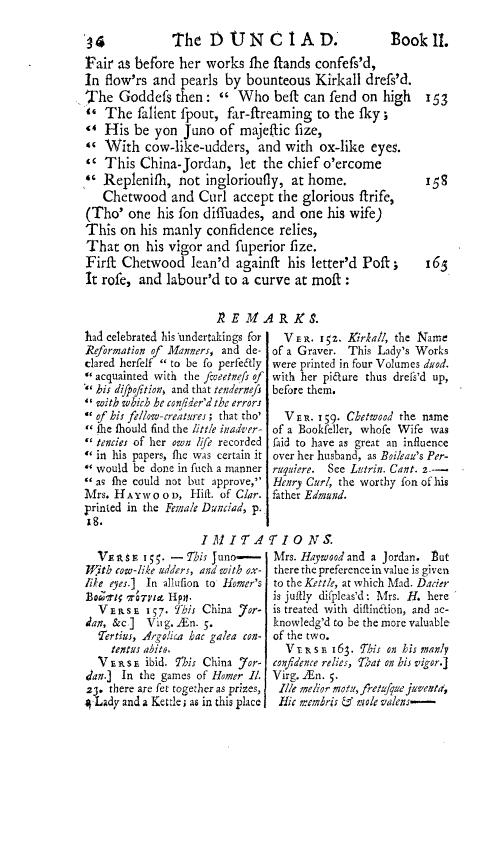
Image Credit: Eighteenth-Century Collections Online
Eighteenth-century satire took various forms, from text and image to performance. Whereas Alexander Pope multiplied footnotes upon footnotes in his 1729 Dunciad Variorum to mock Grub Street figures like Lewis Theobald, Edmund Curll, and Eliza Haywood alongside Grub Street writing conventions, John Gay’s 1728 Beggar’s Opera turned political corruption and popular depictions of criminal life into comic melodies. The period also saw the development of a rich visual satire tradition, as caricaturists like William Hogarth, James Gillray, Thomas Rowlandson, and George Cruikshank satirized eighteenth-century society at large. If satire is meant to enact critique, eighteenth-century satire aimed itself at many different objects. For example, James Gillray’s 1792 print A Voluptuary under the horrors of Digestion directs its ire at the spendthrift Prince Regent, who was known for his excessive eating, drinking, and gambling.
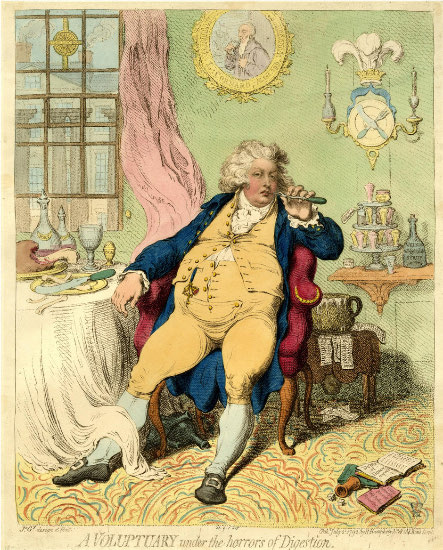
Image Credit: The British Museum
The satire here lies in the careful background details. The feathers and candles surround what should be Prinny’s crest, which here has been changed into a fork and knife crossed across a plate. His bulging gut contrasts with his carefully curled hair and elegant fob. Dice lie on the floor as a dripping pot sits behind him, both signs of his conspicuous consumption. The print hanging on the wall depicts Luigi Cornaro, a Venetian nobleman who famously wrote The Sure and Certain Method of Attaining and Long and Healthful Life, a text reprinted multiple times during the eighteenth century. Gillray juxtaposes the two gentlemen not only to contrast the wastefulness of “prince of whales” with Cornaro’s sobriety, but also to generally indict upper-crust voluptuaries. If other satirists openly critiqued the fop and the macaroni as cultural types, Gillray took on the most famous and powerful example of them all.
Today’s satire groups around similar topics, but its different forms enable different effects. For example, the Binders Full of Women meme consists of images which sprung up on Facebook and Tumblr quickly after Romney answered a question about gendered pay inequity during the second presidential debate with a story of how he chose women for his gubernatorial cabinet from “whole binders full of women.” Like all memes, the visual requires popular cultural knowledge to interpret.
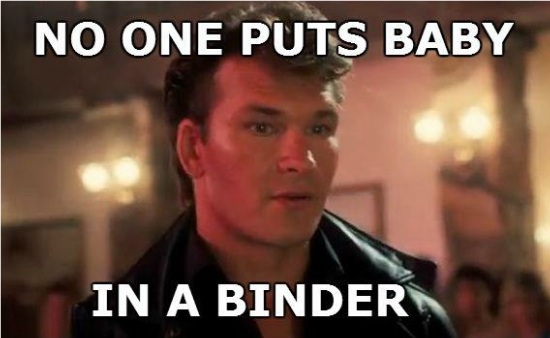
Image Credit: Binders Full of Women
This example takes a screen still from the 1987 movie Dirty Dancing and overlays on top of it a rewritten line from the film: “No one puts Baby in a corner” is now updated to “No one puts Baby in a binder.” The reinterpretation works insofar as the viewer recognizes the original context, where Patrick Swayze’s Johnny Castle shows up at the movie’s conclusion to encourage the character Baby to dance with him, and thus rebel against her family’s attempts to enforce gendered and class-based restrictions. Thus, by juxtaposing Romney’s statement with this image, the meme connects Romney with similar forces of gendered oppression.
But what are the meme’s uses? The Democratic Party quickly adopted and employed the meme to articulate arguments against many of Romney’s policy stances, co-opting the popular response for political purposes of their own. Yet commentators like Amanda Marcotte have argued that Romney’s earlier attempts to seek out qualified women for political positions are good policy, if oddly expressed. In other words, while the meme works to satirize the popular image of Romney as a patriarchal figure—and the language of restraint inherent in the word “binders”—its cultural extensions may in fact work to ridicule policies that do benefit women.
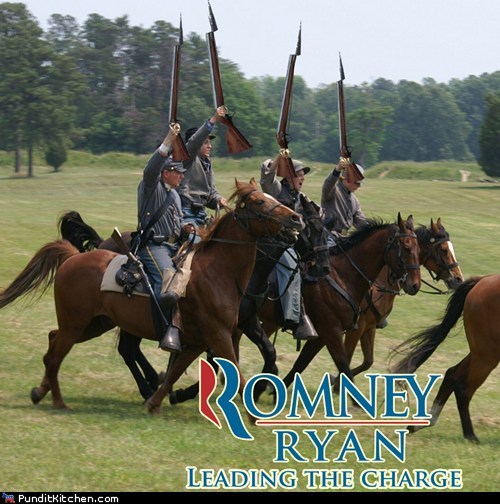
Image Credit: The Daily What
The Horses and Bayonets meme, which developed after a comment by President Obama during the last debate in which he criticized Romney’s comments on defense cuts, likewise overlays text and image to make a pointed statement. In this case, the meme gets reimagined into a Romney/Ryan slogan where Civil War re-enactors with rifles are “leading the charge” for the Republican team. The obvious Photoshopped rifles included not only suggest a link to the NRA, but also an underlying violence within the political debate.
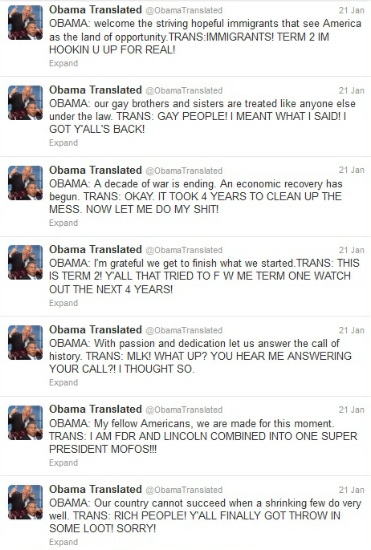
Image Credit: Screenshot from Twitter
Similarly, many satirists enacted political commentary by creating parodic Twitter accounts. Taking advantage of the first-person expressive mode of the platform, individuals as varied as Paul Ryan Gosling, Diamond Joe Biden, Bane Capital, Big Bird, Rafalca Romney, and Mexican Mitt Romney began to comment on the election both in and through the persona of political actors. As Bane Capital, playing off Rush Limbaugh’s comment that The Dark Knight Rises was attempting to smear Romney because the movie’s villain was named Bane, tweets as a pathological venture capital firm ready to “free Gotham’s people… from taxes on income above $250,000 per year,” the feed played on public perceptions about Romney’s morally-dubious business ethics. On the other side, Obama Translated juxtaposes Obama’s celebrated coolness with the popular imagination of what an angry black man would say. In the picture above, we see how Obama's anger translator Luther reads Obama's inaugural address. This feed, however, differs from many of the other Tumblr or Twitter-based satire of the election in that it is still ongoing—and created by Key & Peele, a comedy duo with a Comedy Central show.
Looking back upon the variety of political memes, it’s easier to see how they functioned and what they could do. An account like Obama Translated in part continues to have life not only because Key & Peele have branded the idea, but also because Obama remains a powerful figure. Something like Binders Full of Women may still be able to comment on sexism, but Romney’s fall means that he is no longer the most useful means through which to do so. However, perhaps the difference between something like Paul Ryan Gosling and Gulliver’s Travels has much to do with the medium. While Gulliver responded to a political moment, its method of publication provided the kind of narrative and conclusion that new media platforms don’t, without specifically building towards it (as in the case with Mayor Emanuel). It may also have to do with the status attendant the book as an object that new media has not yet had the chance to obtain—in other words, we see A Modest Proposal as something worth preserving, but not Bane Capital. Yet as I’ve read through eighteenth-century satires that attack the Duke of Newcastle’s 1750 election to Cambridge’s chancellorship, I have to work hard to reconstruct the moment. If eighteenth-century satire favors only slightly-veiled characterizations that make identification a guessing game for readers, new media satire retains all the same karotic specificity, but builds through repacking cultural products in new ways. I’ll be interesting to see what afterlives new media satire finds in the time to come.






Recent comments
2 years 29 weeks ago
2 years 44 weeks ago
2 years 44 weeks ago
2 years 50 weeks ago
3 years 4 weeks ago
3 years 4 weeks ago
3 years 4 weeks ago
3 years 6 weeks ago
3 years 6 weeks ago
3 years 6 weeks ago